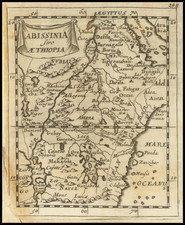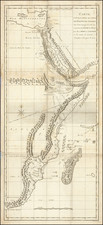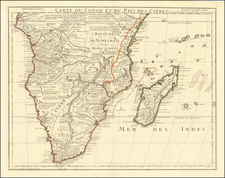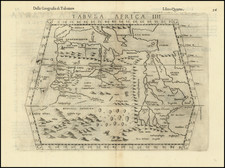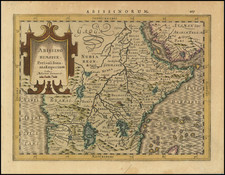This fine map of the Nyassa-Tangyanika Plateau offers a compelling portrayal of Africa's heartland in the late 19th century. Published by the Royal Geographical Society, this map illustrates the extensive paper presented to the Royal Geographical Society by H.H. Johnston, a distinguished British explorer and diplomat, between Lake Tanganyika, Lake Nyassa (now Lake Malawi), and Lake Rukwa.
Sir Harry Hamilton Johnston, born in 1858, was a British explorer, botanist, and linguist, and he served as the British consul in various parts of Africa, including Mozambique. His journey, highlighted in red on the map, provides crucial insights into this region during an era marked by European colonial expansion and growing scientific curiosity about the African continent.
The region between Lake Tanganyika, Lake Nyassa (now Lake Malawi), and Lake Rukwa, was inhabited by various ethnic groups, including the Bemba, Yao, and Nyamwezi, each with their unique cultures and languages. Until the mid-19th century, the area had seen the rise and fall of indigenous kingdoms and the impact of Arab traders and slavers, particularly from Zanzibar.
The onset of European exploration in the mid-19th century brought unprecedented changes. The most significant explorations during this period were David Livingstone's, who was the first European to see Lake Nyassa in 1859, and subsequently Lake Tanganyika in 1869.
The "Scramble for Africa" at the end of the 19th century saw European powers partitioning Africa among themselves. The region between the three lakes fell into the spheres of German East Africa (Tanganyika) and British Central Africa (Nyassa). These colonial powers brought significant changes, from Christianity and formal education to new agricultural practices and forced labor systems.
Henry Hamilton Johnston
Sir Harry Hamilton Johnston, born on June 12, 1858, was an eminent British explorer, botanist, linguist, and colonial administrator. His rich and multifaceted career spanned various facets of African exploration, scientific research, and diplomatic negotiations that have had lasting historical and cultural impacts.
Johnston's educational journey began at King's College London and continued at the Royal Academy, where he studied painting. However, it was the call of the wild, particularly the exotic lure of Africa's diverse wildlife, that steered his career towards exploration and natural history.
The year 1882 marked a significant point in Johnston’s career when he accompanied the Earl of Mayo on a trip to southern Angola. This voyage ignited Johnston's enduring interest in the African continent. The following year, he met the famous explorer Henry Morton Stanley in the Congo. Johnston was one of the first Europeans to see the Congo River above the Stanley Pool following Stanley, an experience that no doubt fuelled his curiosity and determination to explore Africa further.
His burgeoning reputation as an explorer and his firsthand knowledge of Africa caught the attention of the Royal Geographical Society and the British Association. Recognizing his unique expertise and leadership qualities, these institutions appointed him in 1884 as the leader of a scientific expedition to Mount Kilimanjaro.
The Kilimanjaro expedition proved to be a landmark in Johnston’s career. Not only did he lead the scientific exploration of the region, but he also engaged in crucial diplomatic negotiations. He signed treaties with local chiefs, securing British influence over their territories. These treaties were subsequently transferred to the British East Africa Company, significantly bolstering British colonial control in the region. Johnston’s diplomatic acumen played a vital role in counteracting German efforts to establish their influence in the same territories.
Johnston's talent for languages greatly supported his exploratory and administrative endeavors. He learned various African languages and dialects, which enhanced his interaction with local communities and deepened his understanding of their cultures.
In 1888, Johnston was appointed as Her Majesty's consul in Mozambique, and later in 1891, he became the first commissioner of British Central Africa, present-day Malawi. He made vigorous efforts to curb the slave trade, negotiating treaties with local chiefs who agreed to prohibit the practice.
Beyond his colonial roles, Johnston contributed significantly to scientific knowledge about Africa. His ethnological, botanical, and zoological research has been instrumental in shaping our understanding of Africa’s diverse ecology and cultures. His literary contributions, including a comprehensive ethnography of Kenyan peoples, have been widely acknowledged.
Johnston's later career took him to Tunisia and Morocco, serving as a consul and consul-general, respectively. In recognition of his services, Queen Victoria knighted him in 1896. Although he retired from formal service in 1910, Johnston continued to engage with African studies through writing, painting, and lecturing until his death on July 31, 1927.
Johnston's career – a blend of exploration, scientific discovery, and colonial diplomacy – has had a significant influence on the perception and understanding of Africa during the late 19th and early 20th centuries. His life and work serve as enduring testaments to the spirit of exploration and intellectual curiosity.









![[ The Search for the Source of the Nile ] Nouvelle Carte du Bassin du Nil indiquant la commune origine de ce Fleuve avec les Rivieres du Zanguebar Dressee et Dediee A La Colonie Europeene D'Orient . . . 1858](https://storage.googleapis.com/raremaps/img/small/96196.jpg)
